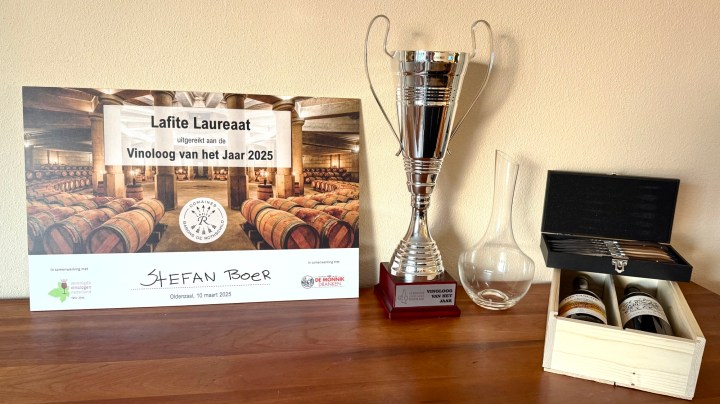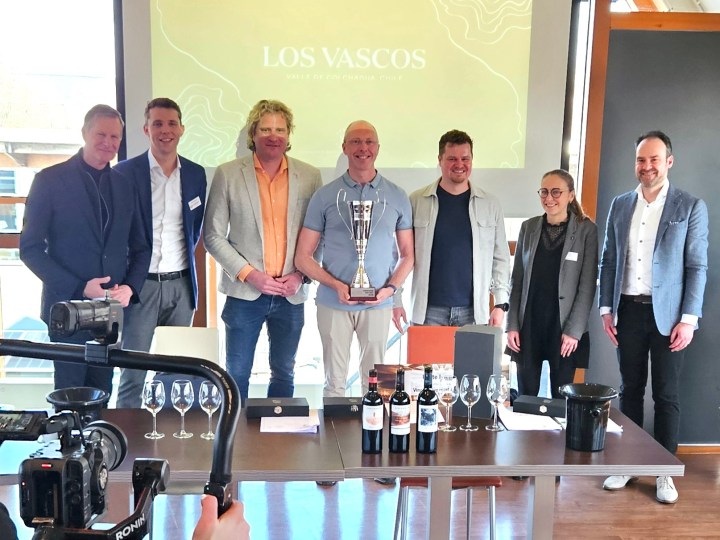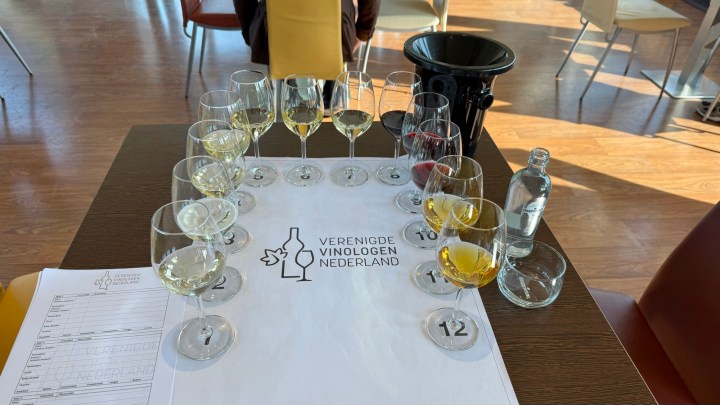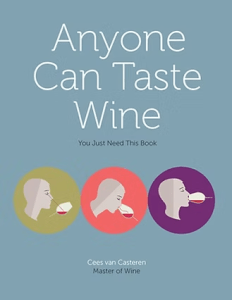
The Lafite Laureate is a wine tasting competition for individuals in the Netherlands. It is organized by the Verenigde Vinologen Nederland (Dutch Association of Vinologists). “Vinologist” is a Dutch title for someone who has passed the Dutch wine knowledge SDEN exam at level 4 (roughly similar to the international WSET). It used to be a competition for vinologists only, but as of this year anyone can participate. The main sponsor is Lafite, and the grand prize for the winner is a visit to Château Lafite Rothschild in Bordeaux, France, with a lunch and tasting at the chateau with the winemaker. To get to the semi-finals, you have to be among the best 20% of the preliminary rounds. The best 10 in the semi-finals go to the finals. The finals for this year were in Oldenzaal on the premises of the other sponsor: De Monnik Dranken. The competition has been organized annually since 1997. I’ve been participating since 2018, mostly to learn and train my wine tasting skills. At the end of each round, the tasting notes and how you could have come up with the correct answer are discussed in detail, which is a great learning experience. I have a disadvantage compared to contestants that work in the wine trade, because they get much more practice in tasting different wines. I mostly drink wine at home and in restaurants, with a bias towards the types of wine that I like. Despite that, it was on my bucket list to win this contest at least once. I already managed to get to the finals twice before, and even came in 3rd in 2020. (It also happened that I was abroad during the semi-finals and had to drop out. This year there was one contestant, Bernard Witzel, who was skiing in Austria, and flew back to the Netherlands just for the day to participate in the finals. It is a good thing that he did, because he came in third.) I am proud to tell you that this year I’ve won the Lafite Laureate and can call myself Vinologist of the Year 2025!

Blind tasting is about recognizing a wine just from tasting it. There is no blindfold involved, because the appearance of the wine is also important. The “blind” part is that you do not get to see the bottles. To be good at this competition, you need tasting skills, knowledge, and analytical skills. The tasting skills include assessing the color of the wine, smelling and recognizing the aromas, assessing the acidity, alcohol level, and sweetness of the wine, as well as the texture of the wine and the tannins. The knowledge comprises the characteristics of all the main grape varieties and wine production areas in the world, as well as wine making techniques. Because of different winemakers and vintages, not all wines of the same grape variety and wine production area are alike. And many winemakers try to make wines that the public likes, so the same trends occur all over the world. So even if your tasting notes, knowledge, and analytics are pretty good, you can still end up at the wrong answer. All of this makes wine tasting a humbling experience.
The selection of the wines and the drafting of the questions for this year’s finals of the Lafite Laureate was done by two Masters of Wine: Cees van Casteren (on the far left in the photo above) and Job de Swart (on the far right). Cees has been doing this for years, and he has won the competition himself twice in 2001 and 2004, before becoming MW in 2012). I have learned a lot from him by participating in this competition. The wines were provided by sponsor De Monnik Dranken. (In theory it would be possible to train for the finals by buying and tasting all of their wines, but with hundreds of wines in their portfolio, that is not really feasible.)

These were the 12 wines that we had to taste and assess. A form was provided for our tasting notes. (It is a good tactic to taste the wines first without looking at the questions, as knowing the question can send you down a tunnel that makes you perceive the wine differently.) There were 25 questions we had to answer about the 12 wines, divided into 5 flights.
The first flight was three sparkling wines. We had to determine by what method they were made, and from what countries. The only clue provided was that two wines were from the same country. The most important methods for making sparkling wines are the charmat or martinotti method (second fermentation in a tank) and the traditional method (second fermentation in the bottle). The most famous charmat method wine is Prosecco and the most famous traditional method wine is of course Champagne. The traditional method can be recognized by what is called autolyse aromas, which are developed by yeast cells that disintegrate as the wine rests after the second fermentation in the bottle. This autolyse aromas smell like brioche or toast. The first wine had only a very faint whiff of toasty aromas, and from the acidity and basic quality I thought it could be Crémant de Bourgogne and thus traditional method from France (which turned out to be correct). The second wine had aromas of pear and yeast, and a different mousse. Because of the yeast I wondered for a second whether this could be a wine where the yeast of the second fermentation is left in the bottle (pétillant naturel or méthode ancestrale). But as the wine was completely clear rather than cloudy, I concluded it should be a (good quality) Prosecco, and thus Italy and martinotti method (which also turned out to be correct). For the third wine, I had no doubt that it was a traditional method because of the strong aromas of toast (which turned out to be correct). It was a high quality with a very persistent mousse, but there are high quality traditional method wines from France, Italy, and Spain. Because of the elevated acidity, I decided it should be Champagne and thus France (which turned out to be correct).
The second flight was three white wines from France. We had to determine the grape varieties and production areas (knowing they were all French). The first wine had a neutral aroma with buttery notes (pointing to malolactic fermentation), some oak, and medium acidity. The main ‘neutral’ grapes used in France are Chardonnay, Chenin Blanc, Pinot Blanc, and Pinot Gris. Because malo and oak are most common in Burgundy, I decided it should be Chardonnay from Burgundy (which turned out to be correct). In fact, it turned out to be Chablis. Chablis is known for its high acidity, but this was a Grand Cru (from the best vineyards with southern exposition) and from the warm vintage 2022, so the acidity was only medium. I am glad that we only had to determine the region and not the appellation. The second wine had an aroma of bruised apple and higher acidity than the previous wine. I immediately recognized Chenin Blanc, which is risky because it can cause tunnel vision, but it turned out to be correct. Loire is the main production region for Chenin Blanc, so I put that for the region (and turned out to be correct). The third wine was the easiest of all twelve wines, and I believe everyone had this one correct. Golden color, very aromatic with lychees and roses, that could only be Gewurztraminer from Alsace (which it was). To make it even more clear, the wine had significant residual sugar (which would have made it easy to distinguish from Gewurztraminer from Alto Adige in Italy, but we already knew it was France).

The third flight was two wines from the same producer in the same country, one white and one red. We had to determine the country and grape varieties, where it was specified that the red was a blend of two. The white one was aromatic and a bit green in both aromas and color, with medium plus acidity and relatively low alcohol. I immediately thought it was a Sauvignon Blanc, which as I said is dangerous because it is hard to get out of such a tunnel once you are in it. The red one had very ripe jammy fruit aromas and aromas of eucalyptus. Just one sniff and I was in Australia (which turned out to be correct). (Reds from Chile can also have a eucalyptus aroma, but the fruit is more perfumed.) The white could be a Sauvignon Blanc from Australia, so that fit with the picture and I didn’t consider other grape varieties as I was sure it wasn’t a Riesling or Chardonnay (the most common whites in Australia). However, that was wrong, because it was a Viognier from Australia. I am very familiar with Viognier from its most famous production zone: Condrieu in the Rhone Valley, France. I’ve tasted Australian Viognier only a couple of times before, and to me it does not have the typical apricot aromas. For the reds I thought I recognized Shiraz and Grenache. I did wonder about this, as the usual blend in Australia is Grenache with Shiraz and Mataro (Mourvèdre). The Shiraz was correct, but the second grape was a Cabernet Sauvignon. In Australia the blend of Shiraz and Cabernet is quite common, but I did not notice any aromas that I associate with Cabernet.
The fourth flight was two reds from the same producer, same grape variety, and the same production area. We had to determine the grape variety and country, as well as which of the two wines was the higher quality. The first wine had a relatively light color, earthy complex aromas, high acidity, and very high grainy tannins that were very astringent. The second wine was also a relatively light color but more purple, lower acidity and tannins, but still aggressive tannins, and candy-like fruity aromas. It was clear that the first wine was the higher quality, as the second was made for easy drinking (which turned out to be correct). The grape variety was more difficult. There are only a few grape varieties with the combination of light color and (very) high tannin, as both color and tannin come from the skin of the grapes. Usually a dark color coincides with high tannin (Cabernet, Syrah, Tannat, Aglianico, Sagrantino, etc.) The exceptions with light color and high tannin are mostly in Italy: Nebbiolo, Nerello Mascalese, and sometimes Sangiovese. It is the latter that did not occur to me during the finals, as Brunello is the most common Sangiovese that has such high and grainy tannin, but I had not tasted Brunello in a long time and Sangiovese wasn’t really on my radar as a grape variety with light color and high tannin. And so I wrote down Nebbiolo, even though especially the second wine had aromas that are not usual for Nebbiolo and so I was not confident about my answer. It was in fact Brunello di Montalcino and Rosso di Montalcino, and so I did not score very well in this question. As I already mentioned, this is not just a contest but also a learning experience. I did feel a bit stupid as it was revealed this was Sangiovese, as Italian wines usually give me an advantage (as a lover of Italian wines).

The final flight was two Coteaux du Layon from the same producer, but different vintage, with similar sugar and alcohol levels. Coteaux du Layon is a sweet wine from the Loire Valley in France, of late harvest Chenin Blanc. We had to determine which of the two wines was the oldest, and the sugar level, alcohol level, and vintage of the first wine (choosing between 1995, 2005, and 2015). I gauged the alcohol level close enough (it was 13.5% and I had put 12.8%, so within the 10% margin), but the sugar too high (it was 90 grams/liter and I had put 113 grams). What was tricky about these wines, was that the first wine had a lighter color than the second wine, whereas the first wine had more developed aromas and tasted less sweet than the second wine (even though it was stated that the sugar level was similar). The fruit aromas of the second wine were more fruity and less developed. White wines darken with age, so from the color the oldest wine should be the second. But sweet wines taste less sweet as they age, and the aroma turns from fruity to developed. So for the taste and aroma, the oldest wine should be the first. (Cees and Job mentioned that this difficulty was not on purpose; the color had been a surprise for them as well.) I decided that the aroma and taste are more important than the color, and put the first wine as the oldest. I put the vintage as 2005 as it was developed, but not as developed as I would expect from a 1995. Both turned out to be correct. The second wine was from 2011.
I did not have a perfect score (and I don’t think it is reasonable to put achieving a perfect score in the finals of this competition as the next item on my bucket list), but I did have the highest score of all the finalists with 20 out of 25 points. And so I will be going to Château Lafite with my husband, and I will definitely write a blog about that. (I heard last year’s winner only went to Lafite recently, so it may take a while.) Thanks to the VVN, Cees, Job, Andrea, Linda, and of course the sponsors for organizing this great event.

If you want to learn more about wine tasting, I can strongly recommend the book “Anyone can taste wine” by Cees van Casteren (available in English and Dutch).


Congrats!
LikeLiked by 1 person
Cogratulations!
LikeLiked by 1 person
Sincere congratulations, Stefan! A hugely well-deserved win about which I learnt on Instagram yesterday – back there after some 14 months !!! (they actually thought I had made ‘inappropriate’ comments!!!) Reading your last restaurant review a few days back I had the feeling Oldenzaal was going to be special 🙂 ! Have found reading your description of the contest very special . . . oh, the palate you have developed with the passing of the years! I am certain you do not smoke! Am certainly keeping this post as any and all of us can learn SO much from your descriptions – thanks heaps! . . . And, Cees van Casteren was here in Australia with you, wasn’t he 🙂 ? bestest . . .
LikeLiked by 1 person
Thanks Eha. Yes, I was in Australia with Cees in 2023. You? Inappropriate comments? How strange 😂 I have not smoked a single cigarette in my entire life (nor cigar or joint).
I thought you’d get a kick out of me recognizing the Australian wine instantly…
LikeLiked by 1 person
I did indeed! Was trying to be diplomatic not mentioning the Australian wine, but certainly did notice it 🙂 ! Yes – trying to grin and not quite succeeding re Insta – I have more than once commented on wanting to ‘reach into the screen’ to taste a dish shown. Would you believe I was supposedly showing a ‘violent trait’ !!!!! Inappropriate! And you try and argue especially when your private world was breaking into pieces 🙂 🙂 🙂 !!! Oh – both my husbands knew a fair amount about wine (not the way you do!) but both smoked like veritable chimneys . . .
LikeLiked by 1 person